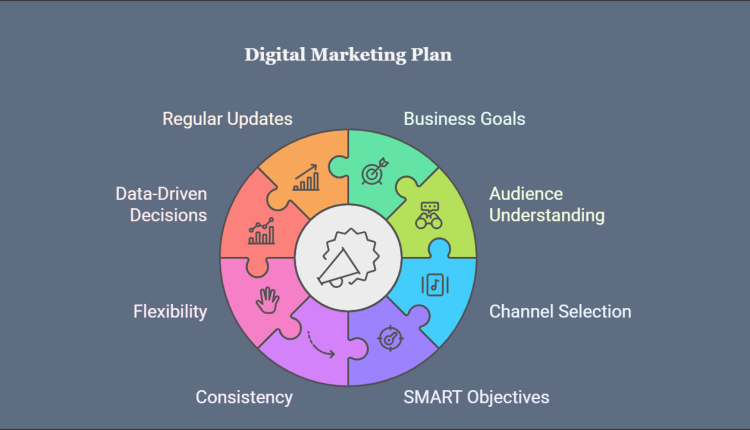
How To Create A Digital Marketing Plan
Creating a digital marketing plan is essential for any business aiming to succeed online. A well-thought-out plan helps you set clear goals, target the right audience, and use the best tools and channels for maximum impact. It also allows you to track progress and improve over time. In this guide, we’ll show you how each step of the digital marketing process connects to build a cohesive and effective strategy.
Understand Your Business Goals
Your digital marketing plan begins with a clear understanding of your business goals. Whether you aim to increase sales, build brand awareness, or boost customer loyalty, these goals should align with your overall business vision.
Identifying both short-term and long-term objectives ensures your marketing efforts remain focused and adaptable to change. For example, if your goal is to increase website traffic, this will influence your content strategy, channel selection, and budget allocation.
Identify Your Target Audience
Knowing your target audience is the foundation of any successful digital marketing plan. By understanding their demographics, behaviours, and preferences, you can create content and campaigns that resonate with them.
For example, if your audience consists of young professionals, you might focus on LinkedIn and Instagram for engagement. Tools like surveys and social media analytics are invaluable for gathering data, which also supports competitive analysis and content development.
Conduct a Competitive Analysis
Analyzing your competitors helps refine your strategy by identifying gaps and opportunities in the market. For instance, if a competitor has a strong SEO presence but weak social media engagement, you can capitalize on that platform to gain an edge.
Insights gained from tools like SEMrush or Ahrefs also guide decisions about your marketing channels and content types, ensuring your efforts are both unique and effective.
Choose Your Digital Marketing Channels
Once you understand your audience and competitors, selecting the right digital marketing channels becomes easier. If your target audience is active on Instagram and Facebook, your strategy should prioritize social media campaigns on these platforms.
Meanwhile, SEO and email marketing can complement these efforts by driving organic traffic and nurturing leads. A balanced mix of channels maximizes your reach and aligns with your business goals.
Set SMART Marketing Objectives
SMART objectives Specific, Measurable, Achievable, Relevant, and Time-bound bring clarity and direction to your efforts. For example, instead of simply aiming to increase website traffic, a SMART goal might specify achieving a 20% increase in website visitors within three months.
These objectives serve as benchmarks that inform your content strategy, budget allocation, and measurement tools.
Develop a Content Strategy
Your content strategy ties directly to your audience, channels, and objectives. By creating relevant and engaging content whether blog posts, videos, or infographics you build trust and drive action. For instance, if your goal is to boost conversions, you might create case studies or customer testimonials.
A content calendar ensures consistency, while regular reviews keep your strategy aligned with your goals and evolving audience needs.
Budget Allocation for Digital Marketing
Budget allocation ensures your resources are used effectively. For example, if paid ads yield high conversions, you might allocate a larger portion of your budget to this channel.
Conversely, if SEO provides steady organic traffic, investing in keyword research and content creation could offer better long-term returns. Regular performance tracking helps fine-tune budget distribution for maximum ROI.
Choose Tools and Platforms
The right tools streamline your efforts and enhance efficiency. Google Analytics, for instance, tracks website traffic, while platforms like GetResponse simplify email campaigns. Social media management tools like Buffer or Hootsuite optimize posting schedules and engagement.
Ensure your tools integrate seamlessly for smoother implementation and better data analysis, which also supports measuring results and refining strategies.
Implement Your Digital Marketing Plan
Execution is where all the planning comes together. Create a timeline with clear deadlines for each task, from content creation to campaign launches. Use your chosen tools to manage and monitor activities, ensuring alignment across all channels.
Flexibility is key adjust tactics as needed based on real-time data. Consistent communication within your team ensures everyone stays on track.
Measure and Analyze Your Results
Regularly measuring your results is critical for ongoing success. Tools like Google Analytics and social media insights provide data on KPIs such as traffic, conversion rates, and ROI. Use these insights to identify successful tactics and areas needing improvement.
For example, if a particular email campaign has a high click-through rate but low conversions, adjusting the call-to-action could improve results. Continuous analysis ensures your strategy evolves with your business.
Conclusion
Creating a cohesive digital marketing plan involves aligning your business goals, audience understanding, and channel selection with a well-defined strategy. Each step builds on the others, from setting SMART objectives to analyzing results. By staying consistent, flexible, and data-driven, you can achieve sustainable online growth. Regular updates and refinements ensure your plan remains effective as your business evolves.
FAQs
1. What is a digital marketing plan?
A strategy that uses online channels to reach specific goals and engage customers effectively.
2. Why do I need a digital marketing plan?
It provides focus, direction, and measurable outcomes for achieving business success.
3. How to pick the best digital marketing channels?
Focus on where your target audience is most active.
4. How do I assess the performance of my digital marketing strategy?
Monitor metrics such as traffic, conversions, and ROI with tools like Google Analytics.
5. How often should I update my digital marketing plan?
Review and update your plan every 3–6 months to ensure it stays aligned with your goals.